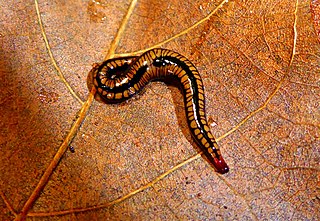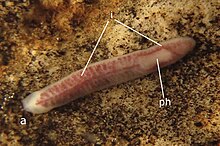
Planarians (triclads) are free-living flatworms of the class Turbellaria., order Tricladida, which includes hundreds of species, found in freshwater, marine, and terrestrial habitats. Planarians are characterized by a three-branched intestine, including a single anterior and two posterior branches. Their body is populated by adult stem cells called neoblasts, which planarians use for regenerating missing body parts. Many species are able to regenerate any missing organ, which has made planarians a popular model in research of regeneration and stem cell biology. The genome sequences of several species are available, as are tools for molecular biology analysis.

Dugesia is a genus of dugesiid triclads that contains some common representatives of the class Turbellaria. These common flatworms are found in freshwater habitats of Africa, Eurasia, and Australia. Dugesia is best known to non-specialists because of its regeneration capacities.
The Lake Pedder planarian is a species of invertebrate in the family Dugesiidae.

Geoplanidae is a family of flatworms known commonly as land planarians or land flatworms.

Dugesiidae is a family of freshwater planarians distributed worldwide. The type genus is Dugesia Girard, 1850.

Girardia is a genus of freshwater planarians belonging to the family Dugesiidae.

Dimarcusidae is a family of triclads found mostly in freshwater habitats of caves, although at least one species, Rhodax evelinae, occurs in surface waters. Currently the family contains only seven species distributed in five genera, although the total number of species is thought to be much higher.

Microplana is a genus of land planarians found in Europe and Africa.

Bdellocephala is a genus of freshwater triclad that inhabits different regions of Eurasia.

Geoplaninae is a subfamily of land planarians endemic to the Neotropical region. Members of this family are sometimes referred to as the Neotropical land planarians. However, one species, Obama nungara has been introduced in Europe.

The reproductive system of planarians is broadly similar among different families, although the associated structures can vary in complexity.

Amaga is a genus of land planarians from South America.

Bogga is a genus of land planarians from South America. It is monotypic, being represented by the single species, Bogga bogotensis, which occurs in Bogotá, Colombia.

Marionfyfea is a genus of land planarians from Antarctic Islands off New Zealand. However, a species has been described from specimens found in Europe, probably introduced.

Marionfyfea adventor is a species of land planarian described in 2016 from specimens found in the United Kingdom, the Netherlands and France. However, since the species belongs to the genus Marionfyfea, of which the species are known only from subantarctic islands off New Zealand, it is probably an introduced species in Europe.

Othelosoma is a genus of land planarians found in Africa and India.
Novibipalium is a genus of land planarians of the subfamily Bipaliinae.

Crenobia is a genus of planarians in the family Planariidae. It is endemic to Europe and Anatolia.
Sarcoplanini is a tribe of land planarians in the subfamily Geoplaninae.
Kawakatsua is a genus of triclad belonging to the family Dimarcusidae. It is monotypic, containing the sole species Kawakatsua pumila. It is known from type specimens found on Barro Colorado Island.













